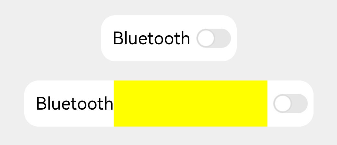Blank
The <Blank> component is able to automatically fill the empty spaces in the container along the main axis. It works only when the parent component is <Row>, <Column>, or <Flex>.
NOTE
This component is supported since API version 7. Updates will be marked with a superscript to indicate their earliest API version.
Child Components
Not supported
APIs
Blank(min?: number | string)
Since API version 10:
- On the main axis of the parent container <Row>, <Column>, or <Flex>, if the size of the <Blank> component is not set, the component will be automatically stretched or shrunk; if the size is not set or the container adapts to the size of its child component, the component will not be stretched or shrunk.
- Relationship between size and min of the <Blank> component on the main axis: max(min, size).
- On the cross axis of the parent container, if the size of the <Blank> component is set, the component will not fill up the parent container; if the size is not set, the component will fill up the parent container, following the default alignSelf settings ItemAlign.Stretch.
Since API version 9, this API is supported in ArkTS widgets.
Parameters
| Name | Type | Mandatory | Description |
|---|---|---|---|
| min | number | string | No | Minimum size of the <Blank> component in the container along the main axis. Default value: 0 NOTE This parameter cannot be set in percentage. If the value is negative, the default value is used. If the minimum size is larger than the available space of the container, it is used as the component size, and the component extends beyond the container. |
Attributes
In addition to the universal attributes, the following attributes are supported.
| Name | Type | Description |
|---|---|---|
| color | ResourceColor | Color to fill the empty spaces. Default value: Color.Transparent Since API version 9, this API is supported in ArkTS widgets. |
Events
The universal events are supported.
Example
Example 1
The sample below shows how the <Blank> component fills the empty spaces in the container in landscape and portrait modes.
// xxx.ets
@Entry
@Component
struct BlankExample {
build() {
Column() {
Row() {
Text('Bluetooth').fontSize(18)
Blank()
Toggle({ type: ToggleType.Switch }).margin({ top: 14, bottom: 14, left: 6, right: 6 })
}.width('100%').backgroundColor(0xFFFFFF).borderRadius(15).padding({ left: 12 })
}.backgroundColor(0xEFEFEF).padding(20)
}
}
Portrait mode

Landscape mode

Example 2
Set the min parameter when the width of the parent container of the <Blank> component is not set.
// xxx.ets
@Entry
@Component
struct BlankExample {
build() {
Column({ space: 20 }) {
// If the width of the parent container is not set, the \<Blank> component becomes invalid. In this case, you can set min to specify the minimum width of the \<Blank> component.
Row() {
Text('Bluetooth').fontSize(18)
Blank().color(Color.Yellow)
Toggle({ type: ToggleType.Switch }).margin({ top: 14, bottom: 14, left: 6, right: 6 })
}.backgroundColor(0xFFFFFF).borderRadius(15).padding({ left: 12 })
Row() {
Text('Bluetooth').fontSize(18)
// Set the minimum width to 160.
Blank('160').color(Color.Yellow)
Toggle({ type: ToggleType.Switch }).margin({ top: 14, bottom: 14, left: 6, right: 6 })
}.backgroundColor(0xFFFFFF).borderRadius(15).padding({ left: 12 })
}.backgroundColor(0xEFEFEF).padding(20).width('100%')
}
}
If the width of the parent container is not set, set min to specify the minimum width of the <Blank> component.
